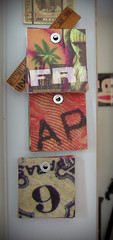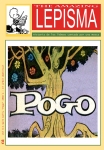 Label for Chanel No. 5, Gabrielle Bonheur "Coco" Chanel, 1921
Label for Chanel No. 5, Gabrielle Bonheur "Coco" Chanel, 1921Story thanks to Michael Bierut
A while ago, I was designing the identity for a large, fashion-oriented organization. It was time to decide which typeface we'd use for their name. Opinions were not hard to come by: this was the kind of place where people were not unused to exercising their visual connoisseurship. But a final decision was elusive.
We decided to recommend a straightforward sans serif font. Predictably, this recommendation was greeted by complaints: it was too generic, too mechanical, too unstylish, too unrefined. I had trouble responding until I added two more elements to the presentation. The first was a medium weight, completely bland, sans serif "C." "Does this look stylish to you?" I would ask. "Does it communicate anything about fashion or taste?" Naturally, the answer was no.
Then I would show the same letter as it usually appears as the first in a six-letter sequence: CHANEL. "Now what do you think?"
It worked every time. But how?
The answer, of course, is context. The lettering in the Chanel logo is neutral, blank, open-ended: what we see when we look at it is eight decades' worth of accumulated associations. In the world of identity design, very few designs mean anything when they're brand new. A good logo, according to Paul Rand, provides the "pleasure of recognition and the promise of meaning." The promise, of course, is only fulfilled over time. "It is only by association with a product, a service, a business, or a corporation that a logo takes on any real meaning," Rand wrote in 1991. "It derives its meaning and usefulness from the quality of that which it symbolizes."
Everyone seems to understand this intellectually. Yet each time I unveil a new logo proposal to a client, I sense the yearning for that some enchanted evening moment: love at first sight, getting swept off your feet by the never-before-seen stranger across the dance floor. Tell clients don't worry, you'll learn to love it and they react like an unwilling bride getting hustled into an unsuitable arranged marriage. In fact, perhaps designers should spend less time reading Paul Rand and more time reading Jane Austen: after all, it is a truth universally acknowledged that a corporation in possession of a good fortune must be in want of a logo, isn't it? Finding that one perfect logo is worth its own romantic novel.
All of this is compounded by the fact that designers themselves have very little faith in context. We too want the quick hit, the clever idea that will sell itself in the meeting and, even better, jump off the table in design competitions. More than anything, we want to proffer the promise of control: the control of communication, the control of meaning. To admit the truth — that so much is out of our hands — marginalizes our power to the point where it seems positively self-destructive. This is especially true in graphic design, where much of our work's functional requirements are minimal on one hand and vague on the other. "The pleasure of recognition and the promise of meaning" is a nice two line performance specification, but one that's impossible to put to the test.
Yet all around us are demonstrations of how effective a blank slate can be. It's just hard to learn from them. I'd like to think, for instance, that I'd see the potential of a red dot in a red circle if I was designing a logo for a company named Target. But in truth I'd probably say, "What, that's all?" and not let it into the initial presentation. How, after all, could you guarantee that the client would invest 40 years in transforming that blank slate into a vivid three-dimensional picture?
Appreciating the power of context takes patience, humility, and, perhaps in the end, a sense of resignation. You sense it in this account of designer Carolyn Davidson's disappointing presentation for her first big ($35) freelance project:
After sifting through the stack of drawings, Knight and the other men in the room kept coming back -- albeit with something less than enthusiasm -- to the design that looked like a checkmark.
“It doesn’t do anything,” Johnson complained. “It’s just a decoration. Adidas’ stripes support the arch. Puma’s stripe supports the ball of the foot. Tiger’s does both. This doesn’t do either.”
“Oh, c’mon,” Woodell said. “We’ve got to pick something. The three stripes are taken.”
That was the trouble, thought Davidson. They were all in love with the three stripes. They didn’t want a new logo; they wanted an old logo, the one that belonged to Adidas. Davidson liked [them] but found it disheartening to go out on her very first real job and get this kind of reception.
We all know the ending to this story: the client grudgingly accepted Carolyn Davidson's chubby checkmark, and the rest, as recounted here in Swoosh: The Unauthorized Story of Nike and the Men Who Played There is corporate identity history. The swoosh has proven durable enough to stand for the company's dedication to athletic achievement, its opponents' resistance to the forces of global capital, and a lot of things in between. Sometimes, the client is smarter than we think. Give Nike founder Phil Knight credit: he had the vision to admit, “I don’t love it. But I think it’ll grow on me."
Maybe he believed it. Or maybe he was just tired of trying to decide. Either way, context did the rest.
That's Right,
HMK




























































